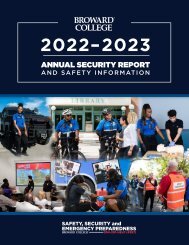AnnualSecurityReport_21-22
Broward College Annual Security Report 2021-2022.
Broward College Annual Security Report 2021-2022.
You also want an ePaper? Increase the reach of your titles
YUMPU automatically turns print PDFs into web optimized ePapers that Google loves.
without jeopardizing life safety. The District Director<br />
of Emergency Management serves as the secondary<br />
person responsible. If he/she is not available or<br />
capable of activating the system, the following<br />
individuals are also able to send out messages via all<br />
BC Alert methods:<br />
• Captain, Campus Safety Operations<br />
• Captain, Security and Support Services<br />
• District Director of Public Relations<br />
• Chief of Staff and Vice President, Communications<br />
and Community Relations<br />
In situations where there is additional time to develop<br />
a message, the District Director of Public Relations<br />
will be responsible for activating BC Alert. This will<br />
be done when it is practical to do so and so long as<br />
life safety will not be jeopardized.<br />
EMERGENCY COMMUNICATION METHODS<br />
The BC Alert emergency notification system consists<br />
of the following delivery methods which are grouped<br />
into three categories: primary, secondary and tertiary.<br />
Broward College recognizes the following system as<br />
the standard means of emergency communication.<br />
Primary<br />
These are the primary notification methods that<br />
should be relied on the most. In any full-fledged<br />
warning, these methods will be utilized. In some<br />
cases where only a partial alert may be required,<br />
only a select few may be used.<br />
• HOME PAGE (broward.edu): The College has the<br />
ability to post emergency notification messages<br />
on its public website at broward.edu.<br />
• DESKTOP ALERTS – TO INCLUDE SELECT<br />
PUBLIC DISPLAY MONITORS: The College has the<br />
ability to pop up emergency alert messages on<br />
the screens of currently running computers, such<br />
as classrooms, libraries, computer labs, meeting<br />
rooms, offices, as well as Broward College laptops<br />
connected to the network.<br />
• SMS TEXT MESSAGES: The College has the ability<br />
to send SMS text messages to registered phones<br />
of current students, faculty, staff and authorized<br />
community partners.<br />
• E-MAIL: The College has the ability to send e-mail<br />
messages to the official Broward College email<br />
addresses of current students, faculty, staff and<br />
authorized community partners.<br />
• VOICE PHONE CALLS: The College has the<br />
ability to make voice telephone calls to registered<br />
phones of current students, faculty, staff and<br />
authorized community partners. Voice calls also<br />
include communications directly to Classroom<br />
Emergency Phones.<br />
• BROWARD COLLEGE SAFETY APP: The College<br />
can push emergency notifications through the<br />
Broward College Safety Application. This works<br />
for those users who have downloaded the<br />
application and have notifications turned on.<br />
Secondary<br />
While many of the following delivery methods may<br />
also relay warnings, they are considered secondary<br />
because they may not be used in every case or may<br />
have some delay associated with them.<br />
• FACEBOOK: The College has established an<br />
official Broward College page Facebook. Alerts<br />
may be published to this account: facebook.com/<br />
BrowardCollege.<br />
• TWITTER: The College has established a distinct<br />
and official Broward College presence on Twitter.<br />
Alerts may be published to this account: twitter.<br />
com/BrowardCollege<br />
• MEDIA ADVISORY: The College’s Public<br />
Information Officer has the ability to issue<br />
media advisories.<br />
• HOTLINES: The College has access to<br />
various hotlines which may be used to share<br />
specified information.<br />
Tertiary<br />
The following delivery methods may also relay<br />
emergency information, but they either have a<br />
substantial delay associated with them or are not<br />
within the direct administrative control of the College.<br />
• NOAA WEATHER RADIO: The College relies, in<br />
part, upon the use of NOAA weather radios for<br />
the dissemination of severe weather watches,<br />
warnings and advisories. NOAA weather radios<br />
are readily available for purchase by Broward<br />
College departments and the general public from<br />
numerous local and online retailers.<br />
• TELEVISION, RADIO, NEWSPAPER AND ONLINE<br />
MEDIA: Broward College considers its media<br />
partners to be a critical part in emergency<br />
notifications and information sharing. As it is<br />
the usual role of news media outlets, if there is<br />
a significant emergency at Broward College,<br />
Broward College can expect its media partners to<br />
cover the story and get the word out.<br />
• WORD OF MOUTH: While this may be the<br />
emergency communication method Broward<br />
College can control the least, it cannot be<br />
discounted. Word of mouth re-dissemination of<br />
BC Alert emergency information is one of the<br />
most effective and critical delivery methods<br />
available. Community members can do their<br />
part by relaying official BC Alert emergency<br />
information to peers, friends, family members, or<br />
pretty much everyone seen on campus. Repost.<br />
Retweet. Quote. Whatever it takes to spread the<br />
word. Part of the responsibility for participants<br />
spreading information is to make sure that it is<br />
current and accurate. Individuals should only<br />
share BC Alert information.<br />
The alert may come to all registered users in the form<br />
of an email, a text message, a voice call, on-campus<br />
network-based computer screen interruptions, and<br />
25 Broward College

















